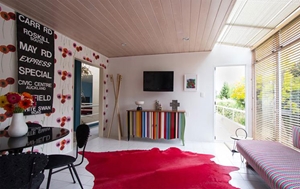
Home decorating ideas seem almost infinite – you can choose between neutral and bold colour schemes, pay homage to a particular design movement, play with textures or simply create your own sense of style at home.
Sometimes, a little guidance can prove helpful. If you've ever thought about incorporating the postmodern trend into your interior design, these pointers may give you the nudge you need to revamp your home. From unpacking the trend itself to selecting the right furniture, we've got all the tips.
What is postmodern design?
Postmodernism was a reactionary movement to modernism, emerging in the 1960s. As the heydey of free thought, postmodernism developed its roots in a world where questioning the establishment was the norm.
It firmly rejected the functional restraints of 19th century modernism and instead embraced fluid lines, unconventional angles, bright colours and a cornucopia of materials and textures.
In the context of home design, postmodernism focuses of form rather than functionality. Furniture takes on a life of its own – acting as much as sculptural features of the space as useful items for sitting on, or otherwise.
Postmodernism has had a huge impact, as a thought movement that infiltrated everything from art to philosophy.
Pick the right furniture
If you're going to do the postmodern thing properly, start with your furniture.
Laminate, fiberglass, concrete, marble and recycled materials are all valid materials when playing up the postmodern theme. If you want to foray into this design trend in a measured way – perhaps to avoid hurting your wallet – start with a space such as the dining room.
Transparent red chairs in a shade similar to Resene Havoc will make a striking impact – opt for varieties that have creative chair legs, whether that means they're a unique material such as brushed steel, or have a playful, curvaceous quality to them.
Lampshades shouldn't merely be functional. Choose decorative pieces that have a sense of playfulness about them – this is easily achieved by opting for lampshades that have an obvious – if not outlandish – sense of curvaceousness about them. Glossy white laminate lampshades with a decorative chain will look stunning above the dining table – but don't stop there.
Decorative vases – whether bulbous or of a sharper, geometric design – will help tie the theme together nicely.
Once you've given the dining room a makeover, think about taking the trend to the kitchen or living space. Breakfast bar stools, couches, chairs, coffee tables, rugs and indoor sculptures can all help hammer home the postmodern vibe.
Be playful and have fun!
Choose the right shades
Pick complementary and contrasting colours as you please, but opt for block shades, from furniture to curtains. While there may be a sense of haphazardness with postmodern design, it is somewhat measured. This design aesthetic is characterised by a continuous fluidity, so pick block colours over patterns when selecting key pieces of furniture, as well as curtains and carpet.
For an instant boost of colour, select a piece of art that plays to the postmodern aesthetic.
Along with the suggested bold red shade, play with warm white, azure blue, canary yellow and hunter green, as you please. Thick black lines – whether in paintings or furniture accents – add definition, while neutral shades will help balance out the brighter tones.
If you're uncertain about painting an entire room a bright shade, start building up your appreciation for postmodernism with moveable pieces, from storage units to rugs and chairs. Once you get more confident, you can give the walls a lick of peppy paint.


